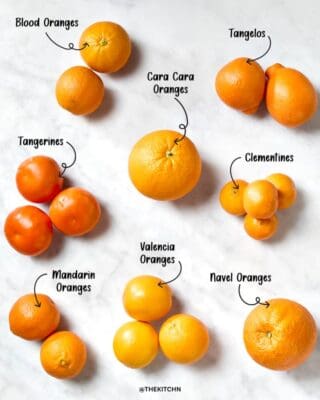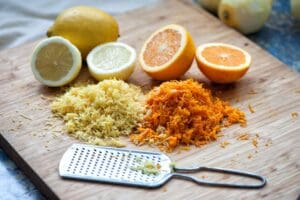About Oranges 🍊
This page focuses on big round oranges, the most common type of oranges found in supermarkets. Many popular names, like Sunkist or California oranges, are actually brand names or marketing terms for oranges grown in specific regions or with a specific method. Oranges are part of the citrus family, and this site has separate guides for other citrus fruits like tangerines, grapefruits, lemons, and more.
The selection of oranges available in your city may vary depending on the season, region, and store. While the best way to know the subtle differences between varieties is to taste them yourself, this guide provides a general analysis of the most common types, their flavors, and best uses to help you make informed choices.
Oranges may vary in sweetness. Some may even be sour. “Zesty” and “refreshing” are common words used to describe the taste of oranges. Oranges are round in shape, and their sizes will vary depending on the variety.

What to Look For 🔍
- Firm oranges with smooth, bright skin.
- Heavy for their size: Heavier oranges are juicier.
- A fresh, citrusy smell.
- Skin thickness: Thicker skin can be easier to peel, while thinner skin often indicates juicier fruit.
- The variety matters: Choose the variety based on your needs—sweet, tart, or easy-to-peel.
- Seeds: Most big round oranges (like Navel and Cara Cara) are seedless, but some varieties (like Valencia) may have seeds. Check the label or ask the seller if you prefer seedless oranges.

What to Avoid 🚫
- Oranges with soft spots, bruises, or mold.
- Dull, wrinkled, or overly rough skin.
- Lightweight oranges (they may be dry inside).
Storage Tips
- Store oranges at room temperature if eating within a few days.
- For longer storage, keep them in the fridge (they can last 2–3 weeks).
- Avoid storing in plastic bags; they need airflow to stay fresh.
How They’re Sold 🛒
- Sold by weight, either loose or in mesh bags.
- Sometimes pre-packaged in trays or boxes.

Why Oranges? 🌟
- Packed with vitamin C, fiber, and antioxidants.
- Refreshing and versatile—great for snacking, juicing, or cooking.
- Naturally sweet and hydrating.
- Relatively long storage life—can last weeks when stored properly.
- Widely available and usually inexpensive.
Ways to Use an Orange 🍽️
- Eating:
- Use your hands to peel the skin, starting at the stem end. Some oranges are easier to peel by hand than others.
- Alternatively, use a knife to cut the orange into wedges or slices for easy snacking.
- Juicing:
- Roll the orange on a countertop to soften it, then cut in half and squeeze to extract the juice.
- For easier juicing, use a kitchen tool like a manual or electric juicer.
- Zesting:
- The outer skin of an orange is called orange zest. It has many culinary uses.
- Avoid the bitter white pith underneath.
- Use a grater or zester to extract the zest, which adds a burst of citrus flavor to baked goods, sauces, and drinks.

Understanding Orange Varieties 🌏
The most common type of orange is the Navel orange, known for its sweet flavor, seedless flesh, and easy-to-peel skin. Navel oranges come in many types and brands, including:
- Cara Cara Oranges: A mutation of the Navel orange, these have pinkish-red flesh and a slightly berry-like flavor.
- Sunkist Oranges: A popular brand that often sells Navel oranges, among other varieties.

Another popular variety is the Valencia orange, which is prized for its juiciness and slightly tart flavor. Valencia oranges are often used for juicing because of their high juice content and balanced sweetness.
Blood oranges stand out for their deep red flesh and unique raspberry-like undertone. They’re sweeter than regular oranges and add a vibrant color to dishes and drinks.
Keep in mind that your local grocer may use brand names or marketing names (like “California oranges”) instead of the actual variety names. When in doubt, ask the seller or check the label for more details.
